
Federal Reserve Chairman Jerome Powell took much of the suspense out of this week’s policy meeting when he said recently he would propose raising interest rates by a quarter percentage point from near zero, which would be the first increase since 2018.
The harder part of Fed officials’ deliberations might be agreeing on how to signal the likely path of rate increases in the months to follow. Worsening inflation, already at a 40-year high, could force them to accelerate the process, but they have signaled they are trying to move carefully to avoid triggering a sharp correction in financial markets.
Mr. Powell told lawmakers earlier this month that, because of the market upheaval triggered by the war in Ukraine, he wanted to avoid adding to uncertainty and to start with a traditional, quarter-point increase rather than opt for a larger, half-percentage-point move. That larger step has been advocated by a couple of his colleagues in recent weeks and some financial-market commentators who say the Fed needs to remove its stimulus faster to demonstrate its seriousness to tame inflation.
Mr. Powell earlier this month laid the groundwork for the possibility of raising rates by 0.50 percentage point, or 50 basis points, later this year. He also suggested the Fed might need to eventually raise rates to a level designed to deliberately slow economic growth.
Escalating sanctions against Moscow as a result of Russia’s invasion of Ukraine are driving up energy and commodity prices while aggravating supply-chain bottlenecks. New pandemic-driven lockdowns in Chinese manufacturing hubs are also set to exacerbate those supply imbalances.
“If not for the geopolitical events, 50 basis points would certainly be on the table at this meeting,” said Nathan Sheets, chief global economist at Citi. “The one thing Powell can do is to hold out the prospect of 50 down the road.”
The economic outlook has already forced a rapid shift among officials’ expectations of how soon and fast they will need to raise interest rates. Even though the Fed hasn’t actually raised rates, communications about its plans have sent up borrowing costs across the economy for everything from business loans to credit cards to mortgages. The average 30-year fixed-rate home loan stood just below 4% last week, according to Freddie Mac, up nearly a full percentage point since the start of the year, and it climbed higher in recent days.
“From a policy-maker point of view, there is at this point no need to shock the economy or shock markets,” said Greg Daco, chief economist at EY-Parthenon, a global consulting company.
Fed officials are set to release their quarterly economic projections on Wednesday, after the conclusion of their two-day meeting. Those will include the interest-rate path that officials individually say would be appropriate under their most likely economic outlook.
Six months ago, half of those officials said the Fed might need to raise rates once or twice this year, while the other half didn’t expect rate rises to begin until next year. In December, nearly all officials penciled in between two and four rate rises this year. Most officials said that would be appropriate given their projection that core inflation, which excludes food and energy, would decline by the end of this year to between 2.5% and 3% from 4.7% in late 2021.
Now, officials are confronting a much bleaker outlook. The Fed’s forecast of a big drop in inflation this year had banked on significant supply-chain relief that might not materialize soon. And there are signs that demand has strengthened, with employers adding more than 1.1 million workers in January and February.
That could lead officials to again ratchet up the number of rate increases they expect this year, with many potentially projecting increases at most or all of their seven remaining meetings this year. That would allow more officials to pencil in short-term interest rates that rise above an estimated “neutral” setting that is designed to neither speed nor slow growth in the coming year.
Fed officials are on guard for signs that price pressures could cause consumers and businesses to expect high inflation to persist, making those expectations self-fulling. If workers anticipate a robust inflation rate in a year’s time, they will be more likely to push for higher wages now.
SHARE YOUR THOUGHTS
What actions should the Fed take to address inflation? Join the conversation below.
“The risks of inflation staying high for a while and moving longer-term inflation expectations up is bigger now and so that will certainly lead them to want to raise rates more than they thought before,” said William English, former senior Fed economist who is now a professor at the Yale School of Management.
In their December projections, most Fed officials said they might not need to raise rates above a neutral level over the following three years. Most officials estimate neutral is between 2% and 3% when underlying inflation—stripped of idiosyncratic influences such as from supply shocks—is at the Fed’s 2% target.
But if underlying inflation rises, that would require the Fed to raise rates even higher to prevent inflation-adjusted, or real, rates from falling. When real rates fall, lending becomes more attractive, risking more spending and higher demand at the same time the central bank is trying to slow growth.
If consumers are expecting higher inflation to stay, “then just to get the same real interest rate, they may have to have a higher nominal rate,” said Mr. English.
An interest-rate increase at the Fed’s next meeting, in early May, is widely expected in interest-rate futures markets.
Mr. Powell could also provide an update Wednesday on how much progress his colleagues have made in fashioning a plan to shrink the Fed’s $9 trillion asset portfolio. The plan could be initiated shortly after the May 3-4 meeting.
Write to Nick Timiraos at [email protected]
Copyright ©2022 Dow Jones & Company, Inc. All Rights Reserved. 87990cbe856818d5eddac44c7b1cdeb8









